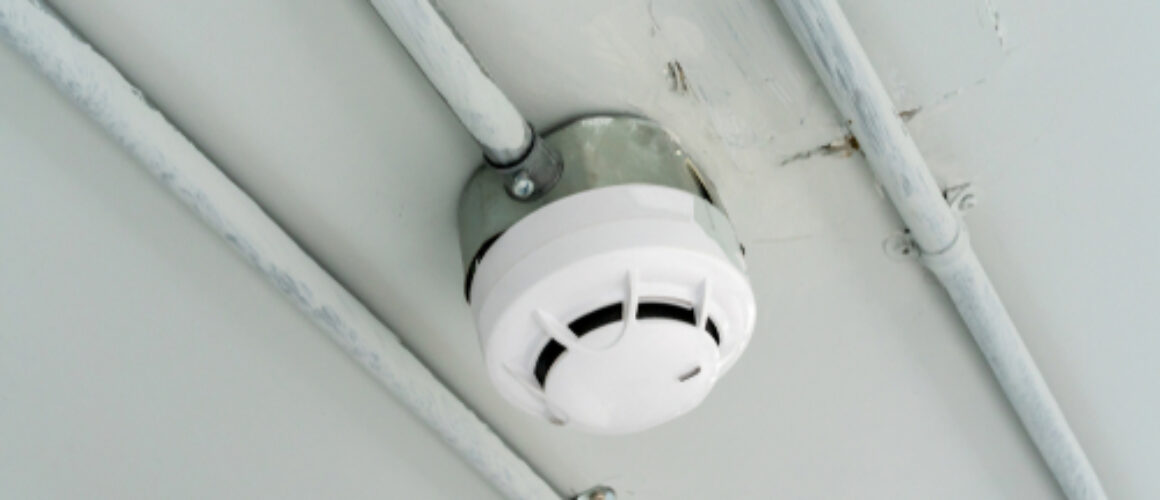The Importance of Fire and Carbon Monoxide Detection Systems
Electrical Discounted Supplies understands the importance of safety in your home or workplace. That’s why we’re here to provide you with essential information on fire and carbon monoxide detection systems, so you can make an informed decision when choosing the right system for your needs. Read on to learn more about these life-saving devices and how they can protect you from potential dangers.
What are Fire and Carbon Monoxide Detection Systems?
Fire and carbon monoxide detection systems are essential for ensuring the safety of your home or workplace. A fire detection system is designed to alert you in case of a potential fire by emitting an alarm or alert, giving you ample time to evacuate the premises. On the other hand, a carbon monoxide detector detects any accumulation of this poisonous gas which can be fatal if left undetected.
Both systems work in similar ways by detecting changes in temperature and air quality within an environment. They are easy to install and maintain, making them a valuable investment for any property owner. It’s crucial that these systems are regularly checked to ensure they’re working efficiently as failure to do so could result in devastating consequences such as loss of life or damage to property caused by fires or carbon monoxide poisoning.
Fire Detection Systems
- Ionisation smoke detectors, photoelectric smoke detectors, and heat detectors are the most common types of fire detection systems.
- Regular maintenance and testing are crucial for ensuring that fire alarms function correctly when needed.
- Integration with sprinkler systems is recommended for maximum protection against fires.
Ionisation smoke detectors work by using a small amount of radioactive material to detect particles created by combustion. Photoelectric smoke detectors use light sensors to detect the presence of smoke caused by a fire. Heat detectors activate when they sense high temperatures or flames nearby.
Regular maintenance such as cleaning, replacing batteries, or checking connections can prevent false alarms or failure during an emergency situation.
Carbon monoxide (CO) can be produced from gas stoves, heaters or fires and it is known as “the silent killer” because it has no smell nor colour but can cause symptoms such as headache and fatigue leading up to death in high concentrations over time. The carbon monoxide detector will set off an alarm alerting people within range if there is carbon monoxide detected in the area.
Carbon Monoxide Detection Systems
Carbon monoxide detection systems use sensors to detect the presence of carbon monoxide in the air. When a dangerous level is detected, an alarm or alert will sound to warn occupants of the area.
The dangers of carbon monoxide poisoning are significant and can result in severe illness or death. Symptoms include headaches, dizziness, nausea, confusion and eventually unconsciousness. Carbon monoxide detectors should be placed on every floor of a property and near sleeping areas for early detection and warning. Regular testing and maintenance ensures proper functioning.
Why are Fire and Carbon Monoxide Detection Systems Important?
Fire and carbon monoxide detection systems are crucial for ensuring safety in both residential and commercial settings. These systems provide early detection of potential dangers, allowing individuals to take necessary measures before it’s too late.
Apart from the obvious safety benefits, having fire and carbon monoxide detection systems installed is also a legal requirement in many regions. Non-compliance can result in hefty fines or even prosecution. Therefore, it’s important to prioritise the installation of these important systems for both personal safety as well as legal compliance reasons.
Safety
Reduce the risk of property damage and protect against injury and loss of life with fire and carbon monoxide detection systems. These systems provide early warning in the event of a fire or gas leak, allowing occupants to evacuate quickly and safely. Not only do they meet legal requirements, but they also provide peace of mind for building occupants knowing that their safety is being prioritised.
Investing in fire and carbon monoxide detection systems is crucial to ensure the safety of your building’s occupants. With these systems in place, you can prevent devastating property damage while protecting lives at the same time. By providing early detection, you can minimise risks associated with fires or gas leaks by taking immediate action before it’s too late. The benefits are clear- make sure your building has these essential safety measures in place today!
Early Detection
Minimising the spread of fires and carbon monoxide poisoning is crucial in ensuring the safety of individuals and property. Early detection systems can detect these dangers before they become life-threatening, allowing for prompt evacuation in case of emergency. This increases the chances of successful firefighting operations and reduces potential damage to property.
Investing in fire and carbon monoxide detection systems is a proactive approach towards safety. These systems provide early warning signs that can save lives, minimise loss or damage, and prevent hazardous situations from escalating into disasters. With advanced technology available today, it has become easier than ever to implement effective early detection measures that safeguard homes, businesses, schools etc., providing peace of mind for all concerned parties.
Legal Requirements
Complying with building codes and regulations is a legal requirement for installing fire and carbon monoxide detection systems. Failure to meet these requirements can result in penalties, fines or even legal liabilities. It’s important that the installation is done by a licensed professional who understands these codes and regulations.
Another legal requirement is ensuring insurance coverage for the property where the detection systems are installed. This will protect property owners from financial loss due to damages caused by fires or carbon monoxide leaks. Adequate insurance coverage ensures that any potential damage can be quickly repaired without significant out-of-pocket expenses.
Different Types of Fire and Carbon Monoxide Detection Systems
Effective fire and carbon monoxide detection systems are crucial in protecting your home or workplace from potential hazards. Smoke detectors, heat detectors and carbon monoxide detectors are the three most common types of these detection systems.
Smoke detectors are essential for detecting smoke caused by smouldering fires before they become large flames. Heat detectors activate when air temperature reaches a certain level, which makes them ideal for use in areas with high levels of dust or steam, such as kitchens or bathrooms. Carbon Monoxide (CO) Detectors can detect harmful levels of CO gas that is dangerous to human health. It’s vital to have all three types installed and regularly checked to ensure maximum safety levels at all times – it could save lives!
Smoke Detectors
Smoke detectors are an important tool for fire safety and come in two types: ionisation and photoelectric. Ionisation smoke detectors are better at detecting small particles from fast, flaming fires while photoelectric ones detect smouldering smokes from slow-burning fires. It is recommended to have both types installed in different areas of the house to ensure maximum protection.
Proper placement of smoke detectors is crucial for their effectiveness. They should be installed on every level of the home, inside bedrooms and outside sleeping areas, near kitchens but away from cooking appliances, and at least 10 feet away from bathrooms with showers or tubs to avoid false alarms caused by steam. Regular maintenance such as cleaning, testing once a month, replacing batteries yearly or when low battery alerts sound can also prolong their lifespan and ensure they function properly when needed most.
Heat Detectors
Different types of heat detectors are available in the market, including fixed temperature, rate-of-rise and combination heat detectors. Fixed temperature heat detectors can detect a sudden rise in temperature above a specific point, while the rate-of-rise detector can sense when there is an abrupt increase in room temperature within a short time. Combination heat detectors use both technologies to identify any fire outbreaks.
Advantages and disadvantages of using heat detectors include that they are more reliable than smoke sensors since cooking or smoking cannot trigger them. However, they may take longer to respond compared to other detection systems like smoke alarms.
Ideal locations for installing heat detectors include areas such as kitchens where false alarms from smoke sensors might occur frequently and garages that may have flammable liquids stored inside. They should also be placed near furnace rooms or attached garages as these areas have higher chances of catching fire due to an electrical fault or fuel leaks.
- Different types: fixed temperature, rate-of-rise, combination
- Advantages: less likely to generate false positives from activities like cooking; more reliable
- Disadvantages: slower response compared with some other alarm systems like smoke alarms.
- Ideal Locations for installation: kitchens, attached garages/furnace rooms
Carbon Monoxide Detectors
How They Work and Why You Need One
Carbon monoxide detectors are essential for protecting your home from the dangers of this deadly gas. Carbon monoxide is odourless, colourless, and tasteless, making it impossible to detect without a detector. Here’s how carbon monoxide detectors work and why they’re so important:
- Carbon monoxide detectors measure the level of carbon monoxide in the air.
- If the level exceeds a certain threshold, the alarm will sound to alert you to danger.
- Some detectors also have digital displays that show you exactly how much carbon monoxide is present.
If you have fuel-burning appliances or an attached garage in your home, it’s especially important to have a carbon monoxide detector installed. Factors to consider when choosing a detector include its accuracy, sensitivity, warranty, ease of use/installation and type (battery-powered vs hard-wired).
In short: don’t take risks with something as serious as carbon-monoxide poisoning! Install at least one CO-detector now – preferably more if there are multiple rooms/floors where people spend time.
Choosing the Right Fire and Carbon Monoxide Detection System
When it comes to choosing the right fire and carbon monoxide detection system, it’s important to consider your specific needs. Think about factors such as the size of your home or building, the number of occupants, and any potential hazards that may be present. This will help ensure you select a system that provides adequate coverage and protection.
Consulting with experts in the field can also be incredibly helpful when selecting a fire and carbon monoxide detection system. Professionals can provide insights into which products are most reliable and effective for your particular situation. Additionally, they can assist with installation and maintenance to ensure everything is functioning properly at all times.
Consider Your Needs
When considering your needs for a fire and carbon monoxide detection system, the size of your property is a crucial factor to consider. A larger property may require more detectors to ensure full coverage and early detection in case of an emergency. The number of rooms in your home should also be taken into account when deciding on the type and number of detectors needed.
It’s important to assess potential fire hazards within your home as well. This includes anything from electrical appliances that generate heat or sparks, to flammable materials stored in close proximity. By identifying these risks, you can choose a fire and carbon monoxide detection system that provides optimal protection for your specific needs.
Consult with Experts
When it comes to installing fire and carbon monoxide detection systems, consulting with experts is crucial. Fire department officials can provide valuable insight into the specific requirements for your area, ensuring that you adhere to all necessary safety regulations. Electrical engineers bring expertise in wiring and electrical components, while licensed contractors can handle the installation process from start to finish.
It’s important not to overlook the importance of consulting with these professionals before embarking on any installation projects. They have a wealth of knowledge that can help ensure proper functioning and maximum effectiveness of your fire and carbon monoxide detection systems. Taking the time to consult with them will give you peace of mind knowing that you’re taking every possible step towards protecting yourself and your loved ones from potential hazards.
Quality Products
Investing in high-quality fire and carbon monoxide detection systems is crucial. Not only can they save lives, but they can also provide peace of mind knowing that your home or business is protected. At Electrical Discounted Supplies, we offer a range of quality products designed to meet industry standards and regulations.
Our selection includes brands with a proven track record in providing reliable and effective fire and carbon monoxide detection systems. In addition, many of our products come with features like remote monitoring and app connectivity for added convenience.
Choose from our range of quality products to ensure the safety of your home or business:
- Brands with a proven track record
- Products that meet industry standards and regulations
- Features like remote monitoring and app connectivity
Conclusion
In conclusion, investing in fire and carbon monoxide detection systems is crucial for the safety of your home or business. Both types of detectors serve unique purposes in detecting potentially life-threatening situations and allowing for quick action to be taken. By installing these systems, you are taking a proactive step towards protecting yourself, your loved ones, and your property from devastating fires or carbon monoxide poisoning.
It’s important to note that while these systems can provide peace of mind, they should never replace proper prevention measures such as regular maintenance checks on appliances and smoke alarms. However, by incorporating fire and carbon monoxide detection into your overall safety plan, you can greatly reduce the risk of harm caused by unexpected emergencies.




